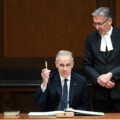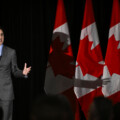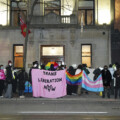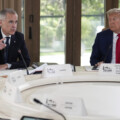Welcome to The Hub’s Federal Election 2021 Policy Pulse, where we’ll be tracking all the policy announcements from the major parties, with instant analysis from our crew of experts.
With the election scheduled for Sept. 20, we’ll be monitoring 36 days worth of policy ideas, so watch out each morning for the day’s live blog where we’ll be tracking every announcement as it happens.
4:15 p.m. — 1,250 Canadians, permanent residents and others still in Afghanistan
The Hub’s associate editor Amal Attar-Guzman updates the situation in Afghanistan:
This morning, Foreign Affairs Minister Marc Garneau said that about 1,250 Canadians, permanent residents and others with Canadian ties are still stuck in Afghanistan. The government will continue to negotiate with the Taliban to attempt to ensure their safe passage out of the country.
The last military flight flew out of Afghanistan yesterday at 11:59 PM Kabul time, meeting the 31st deadline.
Below are the updated final approximate totals of evacuees per country:
- US: 116,700
- UK: 15,000+
- Germany: 5,347
- Italy: 5,011
- Australia: 4,100
- Canada: 3,700+
- France: 3,000+
- Netherlands: 2,500+
- Spain: 2,206
- Turkey: 1,400
Many of the evacuees have arrived in Doha, Qatar, a country that has helped evacuate more than 43,000 people. Qatar has declared that it will work with international partners to settle people in coming days.
The security situation in Afghanistan has been unstable. In retaliation of the two bombings, the Pentagon unleashed an airstrike resulting in the killing of two ISIS-K members. Yesterday, a day before the official deadline, the U.S. intercepted rockets targeted at Kabul airport.
The United Nations Security Council passed a resolution tabled by the U.S., U.K., and France, calling the Taliban to facilitate safe passage for those who want to leave Afghanistan. The resolution also call for the security of Kabul airport and the allowance of foreign aid into the country.
Thirteen of the fifteen members have voted in favour of the resolution. Russia and China have abstained. Prime Minister Justin Trudeau declared that he supports the UNSC resolution.
The Taliban pledged that foreign nationals and Afghans with the correct documents can leave Afghanistan. Over the past few days, thousands of Afghans have left Afghanistan on land to neighbouring countries, especially in Pakistan.
In this morning’s press conference, Immigration Minister Marco Mendicino says Canada will accept 5,000 Afghan refugees evacuated from the United States. Garneau also added that Canada will work with Pakistan and other neighbouring countries to facilitate the entry of Afghan refugees if they arrive at their borders.
3:30 p.m. — A proper review of the tax system could draw multi-partisan support
The Hub’s editor-at-large Sean Speer examines the NDP plan to close ‘tax loopholes’:
Yesterday NDP leader Jagmeet Singh profiled his party’s promise to close “tax loopholes” in the name of improving the progressivity of the federal tax system, increasing revenues to defray the costs of some of his spending promises, and ending the so-called “free ride for the rich.”
The details of the party’s policy are somewhat vague. The NDP policy platform refers to tax loopholes that “benefit billionaires” and the “ultra-rich.” It singles out the stock options deduction in particular but otherwise doesn’t specify any other policies that ought to be eliminated.
The use of “tax loopholes” is common in our political discourse. It aims to convey a sense that individuals and businesses are taking advantage of flaws or gaps in the federal tax code in order to avoid paying “their fair share.”
But the truth is most “loopholes” aren’t inadvertent. They come in the form of tax expenditures – including credits, deductions, and other preferences – that have been deliberately created by federal policymakers.
The federal tax code is chock full of these tax expenditures. They’re a huge (and oft-ignored) part of federal policy. Just consider the following:
- As I observed in a 2020 article for the Canadian Tax Journal, federal tax expenditures represent as much as $118 billion in forgone revenues or more than half of the total revenues collected from income taxes and the GST.
- This amount of forgone revenues is the equivalent of about two-thirds of direct program spending.
- A 2014 study by former Statistics Canada chief statistician Munir Sheikh estimated that the size of government in Canada when accounting for tax expenditures increased from 44 percent to 54 percent of GDP.
Many of these tax expenditures are justified. They prevent double taxation, honour international tax conventions, or incentivize socially-useful behaviour such as work, education, buying a home, or saving for retirement.
But that doesn’t mean that there’s no room for reform. The NDP is right that these tax expenditures are rarely subjected to close scrutiny and generally tilt the overall federal tax system in a more regressive direction.
There’s a good case therefore that they should be reviewed with the goal to eliminate superfluous or regressive tax expenditures. (I’ve previously written, for instance, in favour of eliminating the Age Credit which has been superseded by other seniors programming and costs about $3 billion per year). The net effect could be to enhance the efficiency, equity, and simplicity of the federal tax code.
One wonders if such a process of review and reform could be the subject of multi-partisan support. The Conservative Party, for instance, has committed to “launch a comprehensive review of Canada’s tax system to improve competitiveness, bring down rates and simplify the rules.” The Liberal Party made a similar promise in 2019.
The design and scope of such a comprehensive tax review is beyond the scope of this post. I’ve previously argued in favour of a model that reviewed the tax system using a public check-list to evaluate the efficacy and equity of individual tax expenditures. But others may have different views on how best to carry out such a review process.
The point is that this type of exercise would be far more constructive than railing against the “ultra-rich” who are merely claiming credits, deductions, and other tax preferences that have been put there by federal policymakers. Maybe it can be a source of commonality in the event that we end up with a minority parliament following the election.
2:10 p.m. — O’Toole bucks convention, with one-third of his major announcements coming from an Ottawa hotel
The Hub’s editor-in-chief Stuart Thomson looks at the new campaigning strategy employed by the Conservatives:
Liberal leader Justin Trudeau campaigned today in a western suburb of Ottawa where the party’s candidate is fighting desperately to hold a Liberal seat. NDP leader Jagmeet Singh jetted out to British Columbia where his party is contesting a seat they lost by the slimmest of margins two years ago.
The parties hope, with a little bit of luck, the leader will provide the extra boost they need to win these vital battleground ridings.
Conservative leader Erin O’Toole, on the other hand, spent the morning holed up in an Ottawa hotel and spoke to reporters from an air-conditioned conference room with a blue background behind him.
Even on short clips on the six o’clock news, the different approaches are hard to miss.
In the first 17 days of the campaign, Conservative leader Erin O’Toole made more than one-third of his major daily announcements in the party’s Ottawa studio, forgoing the conventional campaign trail, according to The Hub’s analysis of the travel habits of the major party leaders.
The studio was built because the party feared that a resurgence of COVID-19 cases could shut down in-person campaigning, forcing the leaders to hit the hustings virtually. But even with the other leaders still criss-crossing the country, the Conservatives have enjoyed the benefits of their temporary home.
By the end of last week, the party had reached nearly 200,000 voters with the virtual townhalls that O’Toole conducts from the studio. The outreach also gives the party names and contact information for likely supporters, which will fuel a sprawling get-out-the-vote effort on election day and during the early voting period.
Tamara Small, a professor of political science at the University of Guelph, said the strategy will come with some obvious trade-offs. The benefits are the cost savings from avoiding expensive air travel, which can be funnelled into advertising, and a greater ability to control the message at events.
In any political parties, there have always been mixed feelings about these high-profile visits from the leader. Local campaigns have to devote resources to the major announcement and rallies often pull the most enthusiastic volunteers away from door-knocking duties, where their time may be better spent.
And in a campaign where Trudeau has been dogged by loud and angry protests during his events, the prospect of a serene, air-conditioned television studio is surely appealing.
The visuals, which are important for television news and social media, will likely suffer, though.
A major announcement being confined to a hotel conference room runs the danger of looking “sterile,” said Small.
“Backdrops are important,” said Small. “(In a studio), there’s a lack of a visual message that comes when you do these things in person.”
Small also worried that politicians conducting campaigns virtually might be confined to their own supporters, leading the events to be more partisan than a rally in a local community centre.
In a grueling campaign, some leaders also thrive on the energy they get from working a rope-line of enthusiastic supporters, which is a stark contrast from a quiet room full of sceptical reporters.
Based on their experience so far, the Conservatives think all future campaigns will be fought this way. In a recent interview, Fred Delorey, the party’s national campaign director, told the CBC that he expects this will be the “new standard” for national campaigns.
12:05 p.m. — O’Toole promises balanced budgets in a decade
Conservative leader Erin O’Toole was in Ottawa today to highlight his party’s plan to balance the budget in the next decade.
O’Toole also promised to wind down pandemic supports in a “responsible and compassionate” way, spend on “targeted stimulus measures,” and grow the economy to the extent that the government can eventually balance the budget without spending cuts.
12:00 p.m. — Singh announces plan to raise taxes on house flippers
NDP leader Jagmeet Singh was in Vancouver on Tuesday to announce a plan to raise the capital gains tax on real estate speculators.
Singh said the taxable amount of their capital gains profits would rise from 50 percent to 75 percent.
11:40 a.m. — Fiscal policy deserves more attention than it is getting this campaign
Today Conservative Party leader Erin O’Toole highlighted his promise to balance the federal budget within a decade. It represents the first time that any party leader has confronted the question of Ottawa’s unprecedented deficit and rising debt.
The Hub’s editor-at-large Sean Speer recently appeared on Yahoo Finance Canada’s Crisis Management podcast to talk about the lack of attention paid to fiscal policy issues during the campaign and the long-term consequences of high federal spending and borrowing.
Listen to the podcast here.
11:10 a.m. — Canada’s economy shrinks in second quarter of 2021
The Hub’s editor-at-large Sean Speer and content editor L. Graeme Smith highlight the numbers in Statistics Canada’s quarterly economic report released this morning.
Today’s campaign events will occur against a backdrop of Statistics Canada’s latest GDP figures released this morning.
The statistical agency’s release, which reported on Canada’s economic activity in Q2 2021, showed that the economy contracted at an annualized rate of 1.1 percent. These results diverge from a number of projections which anticipated growth over the quarter.
Primary contributing factors for the quarterly contraction include a 4 percent decline in exports and a sharp 17.7 percent decline in home ownership transfer costs.
This contraction comes on the heels of three consecutive quarterly increases, as the third and fourth quarters of 2020 recorded 9.1 percent and 2.2 percent increases in Canada’s real GDP, respectively, and the first quarter of 2021 showed a 1.4 percent increase.
For the month of July, Statistics Canada provided an initial estimate of a 0.4 percent contraction.
These new figures raise questions about Canada’s economic performance for the year. The Bank of Canada’s Monetary Policy Report from July 2021 had projected the economy to grow at a pace of around 6 percent overall in 2021, primarily driven by increased consumption.
This does not appear to be bearing out, as household spending, which rose 0.7 percent in the first quarter, edged up a mere 0.1 percent in the second quarter. Spending on goods has likewise dropped, as 32 out of 48 categories of goods saw decreases this last quarter.
Due in part to slowed consumer spending, disposable income has increased by 2.2 percent. Increased net savings were bolstered through rising compensation of employees paired with increasing government transfers (though this was partially offset by the 2.8 percent rise in personal income taxes).
Canada’s saving rate reached 14.2 percent, which makes this the fifth consecutive quarter that there has been a double-digit savings rate. Whether due to pandemic-related restrictions still limiting the availability of certain goods, or continued uncertainty amongst a fourth wave of COVID-19, Canadian households are blunting their spending and increasing their savings at a higher rate than was projected.
10:30 a.m. — Trudeau promises new Canada Mental Health Transfer
Liberal leader Justin Trudeau was in the western suburbs of Ottawa today to promise $4.5 billion over five years for a new “Canada Mental Health Transfer” to the provinces and territories.
Trudeau also earmarked $500 million over four years for a student-focused mental health fund that would go toward hiring 1,200 mental health care counsellors at post-secondary institutions.
8:30 a.m. — Conservative drug policy signals a new direction for the party
Jeremy Eckert Devine, a resident physician specializing in psychiatry at McMaster University, examines the Conservative drug strategy:
Last week, Conservative Party leader Erin O’Toole announced plans to invest $325 million over three years to build 50 treatment centers and 1,000 new treatment beds in communities across Canada. O’Toole, characterizing his party’s approach to the opioid epidemic, said: “We want recovery and treatment to be at the core of a national program that recognizes harm reduction.”
The announcement signals the CPC’s vision for a new direction to Canada’s drug policy: one which affirms the value of harm reduction interventions, but ultimately places the drug user’s recovery front and centre.
The party’s platform is surprisingly progressive. O’Toole has emphasized that opioid addiction is a health issue and that the criminal justice system should be reserved for dealers, not users. By affirming the important role harm reduction plays in combatting the opioid epidemic, O’Toole distinguishes himself from his predecessors Stephen Harper and Andrew Scheer, both of whom actively opposed harm reduction interventions.
The CPC’s emphasis on funding recovery options for drug users is a much-needed corrective to a Canadian drug policy pendulum which has swung much too far in the direction of harm reduction.
Since coming to power in 2015, the Liberals have allowed their drug policy to be dictated by vocal drug users and drug decriminalization activist groups all of whom uncritically present harm reduction and drug decriminalization as the solution to the opioid epidemic. The result has been the funding of increasingly extreme, untested, and potentially dangerous harm reduction experiments.
In this vein, the Liberals have spent over $60 million on implementing “safe supply” interventions: the controversial practice of providing highly potent medical grade opioids with minimal oversight directly to those who struggle with an opioid addiction with the tenuous hope that the user will decrease their reliance on dangerous illicit street fentanyl. In August 2020, Health Minister Patty Hadju wrote an open letter urging practitioner to offer a safe supply wherever possible.
Of this $60 million, $5 million has been used to establish several opioid vending machines which directly dispense medical grade opioids. Elsewhere, the highly potent heroin clone hydromorphone is freely distributed to severely dependent drug users.
That these interventions are effective in combatting the opioid epidemic is highly questionable; indeed, the opioid epidemic shows little signs of slowing down. Aside from a small dip in deaths in 2019, opioid overdose deaths have steadily risen each year since 2016. From 2016 to 2020, over 21,000 Canadians have died from an opioid overdose death.
The CPC’s commitment to recovery is a necessary and positive change in direction.
7:00 a.m. — Where the leaders are today
Liberal leader Justin Trudeau will be in Ottawa to make an announcement at 10 a.m.
Conservative leader Erin O’Toole will be in Ottawa at 12 p.m. to make an announcement.
NDP leader Jagmeet Singh will be in Coquitlam, British Columbia at 9 a.m. local time (12 p.m. ET) to make an announcement.
Recommended for You

The Notebook by Theo Argitis: Carney’s One Big Beautiful Tax Cut, and fresh budget lessons from the U.K.

Ginny Roth: How vacant liberal nationalism left Canada worse off than George Grant even imagined

Peter Menzies: Justin Trudeau’s legislative legacy is still haunting the Liberals

‘Our role is to ask uncomfortable questions’: The Full Press on why transgender issues are the third rail of Canadian journalism



